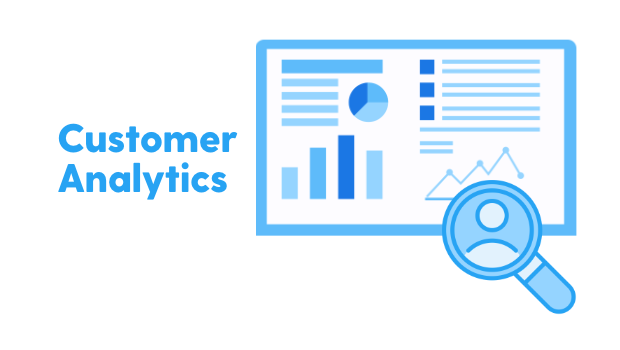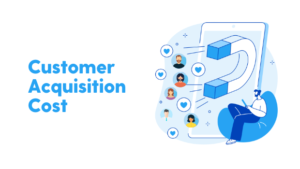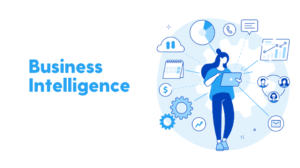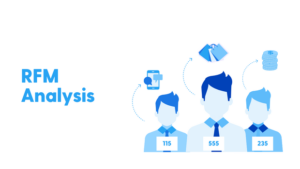What is Customer Analytics
Customer analytics is collecting, analyzing, and interpreting customer behavior data.
Customer analytics aims to understand customer behavior and preferences to make informed business decisions and improve customer experience.
This can include identifying and targeting high-value customers, improving marketing campaigns, optimizing pricing strategies, and improving customer retention.
By understanding customer needs and behavior, companies can make data-driven decisions that lead to increased customer satisfaction and revenue growth.
Additionally, customer analytics helps companies to identify potential frauds and anticipate future market trends.
It is important to note that customer analytics can help create a competitive advantage, improve customer loyalty and retention, increase revenue, and reduce costs.
Additionally, customer analytics can be integrated with other areas of the company, like operations, finance, and marketing, to create a holistic view of the business, leading to more informed decision-making.
Also, read:
Data Collection for Customer Analytics
Data collection is crucial in customer analytics as it forms the basis for analysis and decision-making. Let’s discuss the three key aspects:
- Sources of customer data
- Data collection methods
- Data cleaning and preparation
Sources of Customer Data
Several sources of data need to be used for customer analytics, including:
- Purchase transactions: data on what customers had purchased, how much they spent, and when the purchase occurred.
- Website interactions: data on how customers interact with a company’s website, including pages, visited, time spent on site, and online behavior.
- Survey responses: data collected through surveys or questionnaires that ask customers about their preferences and opinions.
- Social media interactions: data on customers’ interactions with a company’s social media accounts.
- Call center interactions: data on customer interactions with call center representatives, including the reason for the call and the outcome.
- External data: This could include data from third-party providers, such as credit scores, demographic data, and other public data.
Here’s a table listing six sources of customer data and the types of tools or platforms where that data might be siloed:
| Data Source | Tools or Platforms where data might be siloed |
| Purchase Transactions | POS systems, e-commerce platforms, financial systems, CRM systems |
| Website Interactions | Website analytics platforms, web scraping tools |
| Survey Responses | Survey tools, survey platforms, data warehousing platforms |
| Social Media Interactions | Social media monitoring and management tools |
| Call Center Interactions | Call center software, customer service platforms. |
| External Data | Data providers, data warehousing platforms, Big data platforms |
It’s worth mentioning that some of the tools and platforms discussed above may be vague for one data source; for example, some CRM systems like Salesforce or Microsoft dynamics can also collect data from interactions, social media, or surveys. Additionally, some platforms and tools might have several integrations to collect data from various sources and silo it in a single place.
Also, in some companies, the data might be siloed in different departments or systems; it might need to be extracted and consolidated in a central data repository or data warehouse. That’s when you will need the help of data engineers and data warehousing experts to extract, clean, and prepare the data for analysis.
Data Collection Methods
The data collection method will depend on the source of data and the type of data being collected. Some standard techniques include:
- API connections: APIs (Application Programming Interfaces) allow programmatic access to data stored in other platforms or systems. This provides customer data to be collected from various sources, including social media platforms, online marketplaces, and e-commerce platforms. Check out – eCommerce data connectors
- Surveys and questionnaires: Surveys and questionnaires are among the most common methods for collecting customer data. Surveys can collect information about customer demographics, preferences, and opinions. Surveys can be conducted online, by mail, phone, or in person. In addition, surveys can be designed using survey software or online platforms like SurveyMonkey, Qualtrics, or Typeform.
- Web scraping: Web scraping is a method of extracting data from websites. It’s a useful technique for collecting customer data from websites or social media platforms that might need an API to access the data. This can be done using tools like Scrapy, Beautiful Soup, or Selenium.
- Social media monitoring tools allow you to track customer interactions with a company’s social media accounts. They can collect data on likes, shares, comments, and mentions. Some of the popular social media monitoring tools include Hootsuite, Buzzsumo, and Sprout Social
- Log files: Log files are a record of activity on a website or application. They can contain valuable customer data, such as pages visited, time spent on site, and customer behavior. Log files can be analyzed using log file analysis tools like Splunk, Logstash, or Fluentd.
Data warehousing and ELT (Extract, Load, Transform) tools can help to consolidate data from different sources into a single central repository. Once the data is in a central repository, it can be cleaned and transformed in preparation for analysis. ELT tools are an excellent way to handle data collection because they allow data to be extracted from multiple sources, loaded into a central repository, and transformed into a single pipeline before it is analyzed. In addition, ELT tools such as Daton, Alteryx, or Google Big Query data transfer services can help to automate the process and reduce the need for manual intervention.
Data Cleaning and Preparation
Data cleaning and preparation is an essential step, and It involves identifying and correcting errors, inconsistencies, and missing values in the customer data so that it can be used effectively.
The first step in data cleaning is to identify and remove duplicate records. This can be done by comparing unique identifiers such as email addresses or customer IDs.
Next, check missing values in essential fields such as customer name, address, or purchase history. Depending on the specific use case, missing data can be filled in using techniques such as imputation or interpolation.
It’s also essential to check for outliers and errors in the data, such as unusually large or small values. Data entry errors, measurement errors, or data corruption can cause these. Again, identifying and correcting these errors can improve the model’s accuracy.
Data preparation for attribution modeling may also include consolidating data from multiple sources, such as combining data from different systems or platforms. Also, normalizing data across various sources can be vital because it allows data to be compared and analyzed effectively.
In addition to these steps, it may be necessary to perform additional data preparation tasks such as creating new variables, encoding categorical variables, or scaling continuous variables to ensure that the data is in the appropriate format.
Analysis and Interpretation of Customer Data
Analysis and interpretation of customer data are crucial in understanding and making decisions about customer behavior. It involves using various techniques to extract meaningful insights from customer data and transform them into actionable information.
- Statistical modeling and machine learning techniques: These techniques are used to predict customer behavior and identify patterns and trends in the data. Popular styles include regression analysis, decision trees, and clustering. These techniques can be used to predict customer lifetime value, customer segmentation and help identify potential risks and opportunities.
- Data visualization and dashboarding: Data visualization creates graphical representations of data to make it easier to understand and communicate. Dashboarding is the process of creating interactive, web-based visualizations that allow users to explore and analyze data in real time. It helps to develop a clear and simple representation of data, which is easy to understand and share with others, to support the decision-making process
- Insights and decision-making: Once the data has been analyzed, it is essential to extract insights and make decisions based on the information. This step involves interpreting the analysis results, identifying trends and patterns, and making recommendations for how to use the information best to improve customer engagement and business outcomes.
- Using customer journey maps to analyze customer behavior: A customer journey map is a visual representation of the customer’s different touchpoints with a company and their experiences at each touchpoint. These maps can be used to identify pain points and opportunities in the customer experience and develop strategies to improve them.
- Marketing analytics and its role in customer analytics: Marketing analytics uses data and statistical methods to understand and optimize marketing performance and ROI. It plays a vital role in customer analytics because it provides information on how customers respond to marketing campaigns and can be used to improve marketing strategy and tactics.
All these points combined lead to a more in-depth understanding of customer behavior, which can be used to improve the customer experience, increase sales and improve ROI.
Applications of Customer Analytics
There are various ways in which customer analytics can be applied to improve business outcomes.
13 ways in which customer analytics can drive growth for your business:
- Identifying and targeting high-value customers: By analyzing customer data, companies can identify their most valuable customers in terms of revenue, profitability, or lifetime value. This information can be used to target marketing and sales efforts to these high-value customers, resulting in the more efficient and effective use of resources.
- Improving marketing campaigns: Customer analytics can be used to analyze the performance of marketing campaigns in terms of metrics such as click-through rates, conversion rates, and revenue per campaign. This information can be used to optimize campaigns by targeting the most effective channels, messaging, and audience segments.
- Optimizing pricing strategies: Customer analytics can identify customer purchasing patterns and price sensitivity, which can create dynamic pricing strategies that optimize revenue. This can be done by analyzing customer purchase history and customer segments and identifying the right price points for different products or services.
- Improving customer retention: Customer analytics can be used to identify which customers are at risk of churning and design retention programs aimed at keeping those customers engaged and loyal. This can be done by analyzing customer behavior and preferences and identifying patterns of customer churn. For example, companies can create personalized reward programs that are more likely to retain customers successfully.
- Customer segmentation: Analyzing customer data can help identify customers’ segments based on demographic, psychographic, or behavioral characteristics. This can be used to tailor marketing and sales efforts to specific groups of customers, resulting in the more efficient and effective use of resources.
- Personalization: By analyzing customer data, companies can create personalized customer experiences by tailoring the products, services, and content they receive, leading to more effective and efficient customer engagement.
- Predictive modeling: Customer analytics can be used to predict future customer behavior, such as customer churn or purchase likelihood. This information can be used to address potential issues and take advantage of opportunities proactively.
- Customer journey mapping: By analyzing customer behavior, companies can map the customer journey, identifying key touchpoints and the customer’s experience at each stage. This can be used to identify pain points and opportunities for improvement in the customer experience.
- Operational efficiency: Customer analytics can also be used to optimize operations, for example, by identifying the most efficient distribution channels or the products that sell the most in certain regions, allowing companies to make more informed decisions about how to allocate resources.
- Fraud detection: Customer analytics can identify suspicious or fraudulent activities by analyzing patterns of behavior that deviate from standard practices. This can include identifying unusual behavior patterns such as multiple account creation, rapid account opening and closing, or unusual account activity.
- Retention and loyalty programs: Customer analytics can be used to identify which customers are at risk of churning and design loyalty and retention programs to keep those customers engaged and loyal.
- Cross-selling and up-selling: By analyzing customer purchase history, companies can identify patterns of behavior that indicate which customers are more likely to be interested in particular products or services. This information can create targeted cross-selling and up-selling campaigns to increase sales and revenue.
- Social media listening: Companies can use customer analytics to monitor and analyze customer conversations on social media platforms like Twitter and Facebook. By understanding what customers say about their brand and products, companies can gain insights into customer perceptions and make adjustments to improve their reputation and customer relationships.
- Supply Chain Optimization: Customer analytics can help companies optimize their supply chain by analyzing customer demand, stock levels, and logistics data. This can help companies make more informed decisions about optimizing production, inventory, and distribution.
- Revenue Management: Customer analytics can be used to estimate the value of a customer to a business over their lifetime, to help identify the most profitable customers, and to target retention efforts accordingly. Also, it can be used in pricing strategy; by analyzing data on customer purchasing patterns and price sensitivity, companies can create dynamic pricing strategies that optimize revenue.
Overall, customer analytics can be used across different areas of a business and provides valuable insights that can be used to improve customer engagement and business outcomes. With the wealth of data being generated today, having the tools and know-how to analyze and interpret it effectively can be a significant competitive advantage for organizations.
Implementing Customer Analytics
To fully leverage the potential of customer analytics, companies should have robust data management systems to store and process large amounts of data and provide the necessary infrastructure for data-driven decision-making. Additionally, having a skilled team that understands both the technical side of analytics and the business context is crucial to make the most out of customer analytics.
Implementing customer analytics is an ongoing process and requires a combination of technology and human expertise. First, the organization must clearly understand the business problem it is trying to solve with customer analytics and tailor the implementation to suit the company’s specific needs.
Here is a table of some enterprise solutions for customer analytics:
| Tool | Description | Use Case |
| Adobe Experience Cloud | A set of integrated, cloud-based solutions for customer analytics and experience management includes Adobe Analytics, Adobe Audience Manager, Adobe Target, and Adobe Campaign. | It provides a comprehensive view of the customer journey and allows for personalization, segmentation, and campaign optimization, across different channels and touchpoints. |
| IBM Watson | IBM’s cloud-based platform combines AI, analytics, and data management capabilities to provide insights and automate decisions. | Provides end-to-end solutions for customer analytics, including data management, machine learning, and natural language processing. |
| SAP C/4HANA | An integrated suite of cloud-based solutions for customer engagement and experience management includes CRM, marketing, sales, and service. | It provides a unified view of customer data and allows for personalization, segmentation, campaign optimization, customer service, and support automation. |
| Salesforce Einstein Analytics | A set of AI-powered analytics tools is built into the Salesforce platform, including data visualization, predictive analytics, and machine learning. | It provides a comprehensive view of customer data and allows for personalization, segmentation, campaign optimization, customer service, and support automation. |
| Oracle CX Cloud | A set of cloud-based solutions for customer engagement and experience management includes CRM, marketing, sales, and service. | Provides a unified view of customer data and allows for personalization, segmentation, and campaign optimization, as well as automating customer service and support. |
Building a Customer Analytics Team
Building a customer analytics team involves assembling the right combination of people with the skills and expertise necessary to collect, analyze, and interpret customer data effectively.
Here are some key roles and responsibilities for building a customer analytics team:
- Data Analyst: The data analyst is responsible for collecting, cleaning, and preparing data for analysis. They should have expertise in data management, statistical analysis, and programming languages such as SQL, R, or Python.
- Data Scientist: The data scientist is responsible for applying advanced statistical and machine learning techniques to analyze and predict customer behavior. They should have expertise in data science, machine learning, and programming languages such as R or Python.
- Business Analyst: The business analyst is responsible for interpreting the results of the data analysis and making recommendations for how to use the information to improve customer engagement and business outcomes. They should have business analysis, data visualization, and project management expertise.
- Data Engineer: The data engineer is responsible for designing and implementing the data infrastructure necessary for data-driven decision-making. They should have expertise in data warehousing, governance, and management.
- Data Visualization Engineer: The data visualization engineer is responsible for creating and maintaining interactive dashboards and visualizations that allow for easy exploration and analysis of customer data. They should have expertise in data visualization, design, and web development.
- Customer Insights Specialist: The customer insights specialist is responsible for using customer data to identify trends and insights that can be used to improve customer engagement and business outcomes. They should have expertise in customer research, segmentation, and journey mapping.
- Marketing Analyst: Marketing analysts are responsible for analyzing the performance of marketing campaigns and optimizing them for maximum impact. They should have expertise in marketing analytics and tools such as Adobe Analytics or Google Analytics.
- A Team Lead: The team lead oversees the customer analytics team and ensures that it works effectively to achieve the organization’s goals. They should have expertise in customer analytics and solid leadership and management skills.
Also, read:
Challenges in Implementing Customer Analytics
There are 4 primary challenges in implementing customer analytics:
- Cost: Implementing customer analytics can be costly, as it requires investment in data management and analysis tools and the expertise and resources to use them effectively.
- Team: Building and maintaining a skilled customer analytics team can also be challenging, as it requires a combination of technical expertise and business acumen. Finding the right people with the right skills and experience can be difficult, but retaining them can also be challenging.
- Data Quality: Ensuring data quality and completeness is a significant challenge when implementing customer analytics, as it requires processes for data collection, cleaning, and validation. Only accurate or complete data can lead to correct conclusions and decisions.
- Point solutions: Point solutions for customer analytics can be limited in their capabilities and need to provide a holistic picture of customer behavior across different channels and touchpoints.
To know how to overcome these challenges, skip to the conclusion of this article.
Future Trends and Developments in Customer Analytics
Eight trends and developments in customer analytics that are shaping the discourse:
- Artificial Intelligence and Machine Learning: AI and machine learning are becoming increasingly important for customer analytics, as they allow for more advanced analysis and prediction of customer behavior. This can include natural language processing, which allows for studying unstructured data such as customer reviews, and computer vision, which allows for analyzing images and videos.
- Predictive analytics: Predictive analytics is a trend in customer analytics that uses machine learning and other statistical techniques to identify the likelihood of future outcomes based on historical data. This can include predicting customer churn, purchase likelihood, or likelihood of responding to a marketing campaign.
- Real-time analytics: Real-time analytics is becoming more important in customer analytics, as companies want to make more data-driven decisions in real time. This can include real-time monitoring of customer behavior and sentiment or real-time personalization of website or mobile app experiences.
- Multi-channel analytics: The growing number of channels through which customers interact with companies (e.g., website, mobile app, social media, physical store) leads to the need for multi-channel analytics. This allows companies to have a more comprehensive view of customer behavior across different channels and touchpoints, which can be used to improve customer engagement and business outcomes.
- Privacy and Ethical concerns: With the increasing focus on privacy and data protection, many browsers and devices have started to block or limit the use of cookies, making it more difficult to track customer behavior across different channels and devices. This has led to a shift towards using first-party data, which is collected and owned directly by the company rather than by third-party data providers. As a result, companies will need to be more transparent about collecting and using customer data and implement robust data governance practices to ensure compliance with regulations such as the General Data Protection Regulation (GDPR) and California Consumer Privacy Act (CCPA).
- Cloud-based Solutions: Companies are increasingly turning to cloud-based solutions for customer analytics as they offer scalability, flexibility, and cost-effectiveness. Cloud-based solutions also make integrating data from different sources and collaborating with other teams and departments easier. This is expected to increase as more and more data is being generated, giving the need for more advanced and powerful tools for data processing, data warehousing, and data management.
- Unsupervised Machine Learning: Unsupervised machine learning is a technique that involves using algorithms to identify patterns and structures in data without the use of labeled examples. These models are becoming more popular as they can be applied to a broader range of data and have greater scalability. They’re suitable for understanding customer behavior and identifying customer segments, which can be used to improve customer engagement and business outcomes.
- Explainable AI: There is an increasing demand for explainable AI solutions, that is, transparent solutions that can communicate the reasoning behind their predictions or recommendations. This is important for customer analytics as it allows companies to gain a deeper understanding of customer behavior and to make more informed decisions based on the insights generated by AI models.
Conclusion
In conclusion, customer analytics is essential for companies looking to improve engagement and business outcomes. However, implementing customer analytics can present several challenges, including cost, team building and retention, data quality, privacy, ethical concerns, and limitations of point solutions. These challenges can be overwhelming for companies and may result in suboptimal results.
Fortunately, there is a solution to these challenges. Saras Analytics is a proven expert in unlocking the full potential of customer data for hundreds of brands. Our end-to-end approach can overcome the abovementioned challenges and provide a holistic picture of customer behavior with minimal investment.
We offer our service with a flexible pricing model, where we charge just 1% of your annual revenue as the cost of our service. We’re confident that our expertise in data management and analysis and our experienced team can provide valuable insights and deliver results for your company. Contact us today to learn more about how we can help you improve your customer engagement and business outcomes.













